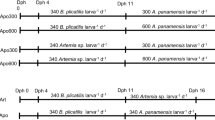Abstract
The total lipid content in Artemia franciscana (21–23% ofdry weight (DW)) when enriched with either Super Selco or DHA Selco wastwice as high as in the adult copepods Temora longicornis and Eurytemora sp.(9–11% of DW). In Brachionus plicatilis the total lipid contentwas 11 and 6.6% for cultures growing at high and low growth rate,0.12 d−1 and 0.38 d−1, respectively. In thecopepodid stages I, II and III of Calanus finmarchicus the total lipid levelwas 12–13%, increasing to 24% in copepodid stage IV, Vand the adults. In T. longicornis and Eurytemora sp. the predominant fattyacids were DHA (22:6n-3), EPA (20:5n-3) and the saturated fatty acid 16:0,which constituted 40–45%, 21–24% and8–12% of total fatty acids, respectively. C. finmarchicuscontained the same dominant fatty acids. In both the cultivated live feedorganisms DHA, EPA and 18:1 were the predominant fatty acids. In A.franciscana the content of these fatty acids varied according to theenrichment medium and in B. plicatilis according to the growth rate.
Similar content being viewed by others
References
Bligh, E. G. & Dyer, W. J., 1959. A rapid method of total lipid extraction and purification. Can. J. Biochem. Physiol., 37: 911–917.
Evjemo, J. O., P. Coutteau, Y. Olsen & P. Sorgeloos, 1997. The stability of docosahexaenoic acid (DHA) in two Artemiaspecies following enrichment and subsequent starvation. Aquaculture in press.
Kattner, G. & M. Krause, 1987. Changes in lipids during the development of Calanus finmarchicuss.l. from copepodid I to adult. Mar. Biol. 96: 511–518.
Léger, P., D. A. Bengtson, K. L. Simpson & P. Sorgeloos, 1986. The use and nutritional value of Artemiaas a food source, Mar. Biol. annu. Rev. 24: 521–623.
Léger, P., D. A. Bengtson, P. Sorgeloos, K. L. Simpson & A.D. Beck, 1987. The nutritional value of Artemia: a review: 357–372. In P. Sorgeloos, D. A. Bengtson, W. Declier & E. Jaspers (eds), ArtemiaResearchand its Applications. Vol 3. Universa Press, Wetteren, Belgium, 556 pp.
Léger. P. & P. Sorgeloos, 1991. Optimized feeding regimes in shrimp hatcheries. In Fast, A. W.,.L. J. Lester (eds), Culture of Marine Shrimp: Principles and Practices. Elsevier.
Metcalfe, L. D., A. A. Schimtz & J. R. Pelka, 1966. Rapid preparation of fatty acids esters from lipids for gas chromatography. Analyt. Chem. 38: 514–515.
Olsen, Y., J. R. Rainuzzo, K. I. Reitan & O. Vadstein, 1993. Manipulation of lipids and ω3 fatty acids in Brachionus plicatilis. In Reinertsen, H., L. A. Dahle, L. Jørgensen & K. Tvinnereim (eds), Proceedings of the First International Conference on Fish Farming Technology. Trondheim, Norway, 9–12 August 1993, A. A. Balkema, Rotterdam, 109–1115.
Rainuzzo, J. R., K. I. Reitan & Jørgensen, L., 1992. Comparative study on the fatty acid and lipid composition offour marine fish larvae. Comp. Biochem. Physiol. 103B: 21–26.
Rainuzzo, J. R., K. I. Reitan & Y. Olsen, 1994. Effect of short and long term lipid enrichment on total lipids, lipid class and fatty acid composition in rotifers. Aquacult. int. 2: 19–32.
Sorgeloos, P., P. Lavens, Léger, P., Tackaert & D. Versichele, 1986. Manual for the Culture and use of Brine Shrimp Artemia inAquaculture. Manual prepeared for the Belgian Administration for Development Cooperation and the Food and Agriculture Organization of the United Nations. Artemia Reference center. Faculty of Agriculture. State University of Ghent, Belgium, 319 pp.
Watanabe, T. & C. Kitajima, 1983a. Nutritional value of live feed organisms used in Japan for mass propagation of fish: a reviw. Aquaculture 34: 115–143.
Watanabe, T., T. Tamiya, A. Oka, M. Hirata, C. Kitajima & S. Fujita, 1983b. Improvement of dietary value of live foods for fish larvae by feeding them on T3 highly unsaturated fatty acids and fatsoluble vitamins. Bull. Jpn. Soc. Sci. Fish., 49: 471–479.
Author information
Authors and Affiliations
Rights and permissions
About this article
Cite this article
Evjemo, J.O., Olsen, Y. Lipid and fatty acid content in cultivated live feed organisms compared to marine copepods. Hydrobiologia 358, 159–162 (1997). https://doi.org/10.1023/A:1003196829109
Issue Date:
DOI: https://doi.org/10.1023/A:1003196829109




